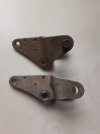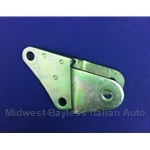You are using an out of date browser. It may not display this or other websites correctly.
You should upgrade or use an alternative browser.
You should upgrade or use an alternative browser.
Reason for two different lengths of "dog bone?"
- Thread starter LarryC
- Start date
-
- Tags
- box dogbone box engine
Ulix
True Classic
Yes, that is the story usually told.
But in reality, that is not the case.
The height of the block has almost no impact on the length needed, as the
length needed, as the  is perpendicular to the height of the block.
is perpendicular to the height of the block.
On my 74 with the tall block, a 1500 makes the engine sit all crooked in the engine bay (although this also depends a lot on how high the bottom mount makes the engine sit).
makes the engine sit all crooked in the engine bay (although this also depends a lot on how high the bottom mount makes the engine sit).
So the needs to be matched to the chassis, not the engine.
needs to be matched to the chassis, not the engine.
I have not analyzed the differences in the chassis to see where exactly the difference is.
But in reality, that is not the case.
The height of the block has almost no impact on the
On my 74 with the tall block, a 1500
So the
I have not analyzed the differences in the chassis to see where exactly the difference is.
ng_randolph
Bjorn H
The early (blue) and late (red) cars are different in that area, so it would make sense that the dog bone is chassis specific.


Dr.Jeff
True Classic
Speaking of the two mount lengths, I recall one of the well known Fiat specialty vendors selling the "long" one as a "short" one after cutting the shaft and rewelding it shorter. Sadly the 'cut and weld' job was inferior work and the resultant mount was 'bent' in the middle, causing the ends to not align with the chassis mounts properly. But it really didn't matter because the rubber bushings in his mounts failed almost immediately anyway. 
I imagine the differences in noted lengths (short = 132 vs 137 and long = 148 vs 152 mm) has more to do with manufacturing from various aftermarket makers than anything specific to the cars. Unless there's a "128" model and "X1/9" model difference that explains it?
My '79 uses the "wrong" one for a 1500, like you say.Yes, these are what one would assume, but some transitional models, for example the early to mid 1979 1500s, use the short one. Also, some parts sites say they are 132 mm versus 152 mm, others say 137mm versus 148 mm. Do we know the actual dimensions?
I imagine the differences in noted lengths (short = 132 vs 137 and long = 148 vs 152 mm) has more to do with manufacturing from various aftermarket makers than anything specific to the cars. Unless there's a "128" model and "X1/9" model difference that explains it?
MikeHynes
True Classic
I believe the bracket that attaches to the cam carrier/dogbone is different for early and late cars. Perhaps that's the reason there are two different lengths of dogbones?
EDIT: I was wrong. I see that the Uno Turbo bracket is different, but I couldn't find any X brackets that were different, other than some had an extra hole drilled in them for a screw to attach a bracket to hold a small hose or wire. Sorry for any confusion.
X on top, 128? on bottom.

EDIT: I was wrong. I see that the Uno Turbo bracket is different, but I couldn't find any X brackets that were different, other than some had an extra hole drilled in them for a screw to attach a bracket to hold a small hose or wire. Sorry for any confusion.
X on top, 128? on bottom.

Last edited:
fiatfactory
Steve Cecchele
The advantage for Fiat was that the longer rod also fits another model (of which they made millions) and they are 152mm longBut that raises the question as to why a new bracket was fitted thus requiring a new longer rod? Is there some advantage of a longer rod?
I don't have my parts books with me but I think you'll find the steel bracket is the same for all X19's, well at least from 1978 model year onwards (which is the Australian market I know)
Early cars could be the same as the 128 steel bracket, which is slightly different to the 78 on X19 steel engine bracket.
SteveC
Ics19
belle macchine!
I believe it's more the chassis mount that's different between the lengths rather than the (cam tower) bracket end:
EDIT - MWB says the bracket is the same:

 www.midwest-bayless.com
www.midwest-bayless.com
X1/9 Engine Mount Top Stabiliser - Long (Late) : Eurosport (UK), FIAT X19 Bertone & Lancia Montecarlo Beta Scorpion spare parts
Eurosport (UK) X1/9 Engine Mount Top Stabiliser - Long (Late) - Engine upper dogbone mount for 1500 models built from 12/1979. This is the long type at 147mm centre to centre as the applicable cars do not have the extended chassis mounting point of earlier models. Fabricated to the correct size...
www.eurosport-uk.net
EDIT - MWB says the bracket is the same:
Motor Mount Upper Dogbone Bracket (Fiat Bertone X1/9 All) - OE / RENEWED
Motor Mount Upper Dogbone Bracket (Fiat Bertone X1/9 All) - OE / RENEWED
 www.midwest-bayless.com
www.midwest-bayless.com
rx1900
1981 X1/9
See below....It just occurred to me that I never really understood why the early models got shorter (137mm) torque rods, tranistion 5-speeds sometimes got the short one, and later 5-speeds got the long (145 mm) rod. Anybody know?
Ulix is correct...So theneeds to be matched to the chassis, not the engine.
I have not analyzed the differences in the chassis to see where exactly the difference is.
No......that bracket did NOT change at the time Fiat changed to the longer dogbone.I believe the bracket that attaches to the cam carrier/dogbone is different for early and late cars. Perhaps that's the reason there are two different lengths of dogbones?
According to the Fiat parts books...the change to the longer dogbone occurred in 12/79, which would have been halfway through the 1980 model year. Which seemed odd as the bracket to the engine did NOT change at the same time. However...upon further digging though the parts book......it seems the chassis crossmember that the dogbone mounts to...also changed at exactly the same time. So i'm assuming that re-positioned the chassis mount further back from the engine...thus requiring a longer dogbone
I'll go with that theory until someone comes up with a better one
Bjorn Nilson
True Classic
If they changed the length of the dog bone must mean that they also changed the location of the other upper engine mount? Otherwise, the engine wouldn't sit in line?
rx1900
1981 X1/9
If they changed the length of the dog bone must mean that they also changed the location of the other upper engine mount? Otherwise, the engine wouldn't sit in line?
No...no.....the only thing that they appear to have changed..is the upper rear crossmember chassis rail where the dog bone bolts onto !!
Upper and lower engine mounts are in the same location. Just where the dogbone bolts onto is now a bit further way from the engine...so a longer dog bone was needed.
Look at this pic:
That bracket on the upper rear crossmenber where the dog bone bolted onto - changed in 12/79 and is now further away from the engine - thus requiring a longer dog bone to keep the engine in the same position as previously....Nothing else changed.....I have no idea why they would make such a change...but it appears they did.....
MikeHynes
True Classic
I believe that rx1900 is correct, I was mistaken. The bracket that attaches the dogbone to the cam carrier seems to be the same on all the X's I have. But, the dogbone seems to have changed when the cars got FI. At least for the ones I have here in the US.
All of the carbed cars I have came with the shorter dogbone ('74, '76, '77, '79). (I don't have a carbed '80.)
All the FI cars that I have have the longer dogbone ('83, '85).
Makes me wonder - did the Euro carbed cars also get the longer dogbone starting in '80?
All of the carbed cars I have came with the shorter dogbone ('74, '76, '77, '79). (I don't have a carbed '80.)
All the FI cars that I have have the longer dogbone ('83, '85).
Makes me wonder - did the Euro carbed cars also get the longer dogbone starting in '80?
